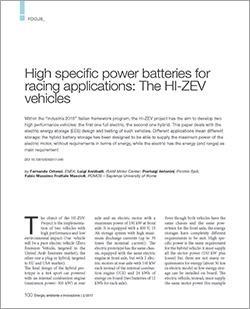
High specific power batteries for racing applications: The HI-ZEV vehicles
by Fernando Ortenzi, ENEA; Luigi Anniballi, ISAM Motor Center; Pierluigi Antonini, Picchio SpA; Fabio Massimo Frattale Mascioli, POMOS – Sapienza University of Rome
DOI 10.12910/EAI2017-040
Within the “Industria 2015” Italian framework program, the HI-ZEV project has the aim to develop two high performance vehicles: the first one full electric, the second one hybrid. This paper deals with the electric energy storage (EES) design and testing of such vehicles. Different applications mean different storage: the hybrid battery storage has been designed to be able to supply the maximum power of the electric motor, without requirements in terms of energy, while the electric has the energy (and range) as main requirement
The object of the HI-ZEV Project is the implementation of two vehicles with high performance and low environmental impact. One vehicle will be a pure electric vehicle (Zero Emission Vehicle, targeted to the United Arab Emirates market), the other one a plug-in hybrid, targeted to EU and USA market).
The final design of the hybrid prototype is a 4x4 sport car powered with an internal combustion engine (maximum power: 300 kW) at rear axle and an electric motor with a maximum power of 150 kW at front axle. It is equipped with a 400 V, 15 Ah storage system with high maximum discharge currents (up to 35 times the nominal current). The electric prototype has the same chassis, equipped with the same electric engine at front axle, but with 2 electric motors at rear axle with 100 kW each instead of the internal combustion engine (ICE) and 24 kWh of energy on-board (two batteries of 12 kWh for each axle). …

